I feel drained should be my motto from this holiday weekend. Three days were spent working on the plumbing to the house. The drains carrying the gray water away from the kitchen sink, wash machine, dishwasher and the basement sub-pump collapsed. I spent all day Friday, Saturday and Sunday getting the old lines opened up and new lines installed. I think that I have finally found something that I hate worse than painting. The worse part of the whole weekend was that friends came up this weekend to help finish the construction on the indoor part of the Raptor Center. We could have easily finished the six remaining aviaries with the 3 days that we spent playing human backhoe in the backyard.
It was a very busy weekend of people coming to see llamas for possible adoption and wildlife coming in that needed my immediate attention also. PLEASE read the blog on emergencies. Click on the link to the NY Wildlife Rehabilitation Council Website. Go to their toolbar, click on find a Rehabber close to me..... I received a call on a duckling in Albany this weekend. If I personally went to pick up every animal that needed my help I wouldn't be home to care for everything else that came in. Remember we are volunteers, we do not get paid, you will have to drive to drop off your wildlife in need right now because most wildlife rehabbers are very busy right now.
We had a baby English Sparrow and a Robin come in this weekend. I know that it is tough to find and get ahold of a licensed wildlife rehabber this time of year but try not to hold on to your orphaned wildlife in need. Often hours make a huge difference in saving an animal. I also had an adult House Finch come in this weekend with the eye conjunctivitis thing going on. Very contagious to other birds, often passed at bird feeders. Seems like only the finch species of songbirds are getting it right now but I am sure it is in other species as well. Nasty and I hope that it doesn't spread more. I was amazed that no fawns have come in yet but I am sure that they will be coming in soon. PLEASE leave them where you find them. 90% of the time they dont need your help and are not orphaned. You can tell when a fawn is orphaned by the way it is acting or if you see the dead doe. Fawns by instinct hide in the grass and dont move.
By sat night, I was sick of large holes and plumbing and decided to get away from the facility, the phone calls, and take the kids fishing. We got to a friends farm to fish on his pond (to be sure the kids caught something). I had hardly cast their lines out and my friend showed up and said "Get in the truck quick....there is a baby fox out in the hay field". I grabbed my catch pole and gloves out of the truck. I was expecting a fox with distemper, mnost likely last years kit. Once we got down there, it was a small kit from this year.
The owner of the barn we were near said that he shot a fox recently right by his barn. I dont know why people illegally shoot animals this time a year. Most wild animals have offspring this time of year. When you shoot the parent, you are leaving behind the offspring to suffer a slow death by starvation. I saw the kit, walked slowly up to the kit and caught it with the catch pole. This little female fox was nothing but bones. I went back and collected my kids that were very upset that we only fished for 10 minutes to get the fox back to our facility. I joked with my wife that I cant even go fishing for an hour to escape being a wildlife rehabber without an animal in need finding me. Unfortunately, this little fox had crossed the line into starvation zone. I tried to get him back but he was too far gone and died in my hands sunday morning as I was feeding him. Since I was the only one exposed, he went into the outdoor wood furnace for cremation.
Later in the day 2 great wildlife rehabbers paid me a visit with a little gray fox that they had been working on. They knew that I had some unreleasable foxes and thought that it was time to get the little guy in a spot where he could see other foxes from the safety of his own enclosure. It is very important that wild orphans be raised with species of their own kind. It really helps them from imprinting on humans. As I was showing the ladies around our facility, they got a call that another rehabber had a baby gray fox. They took their fox back home with them so that they could get the other kit later that night to raise the two together. Very cool ladies, great rehabbers.... it isn't about what we want, it is about what is best for the animal. WE cant get attached because we fall in love with something we are caring for, sometimes we all have to make tough decisions for what is best for an animals....regardless how we feel.
Sunday was spent working on the Raptor Center with my friends.....what I really wanted to be doing all weekend versus plumbing. By 8pm, we had gotten almost all of the framing done...we called it a day and everyone went home. I told my wife that I was drained, couldn't eat dinner. I just wanted to take a shower and go to bed after I got the coons fed.
The wife/kids went for ice cream (they brought me back something) and I was going to be to bed early...or so I thought. The Northcountry Animal Hotline called and said that there was a guy with a baby raccoon that he found along side of a road. I called the guy and he agreed to bring me the coon. I got everything set up. He arrived a short time later and I got to work on the coon. She took the bottle well, I noticed that she had some ticks between her toes. The poor thing is nothing but skin and bones....much like the red fox was that died on me because I didn't get it soon enough. As the starving coon was nursing, I started removing ticks. Over 50 ticks later, I have most of them off. I removed almost 20 ticks from the inside of each of her ears. She was amazingly good. She just nursed on her bottle as I removed the blood sucking parasites that would kill her in this weakened state. I am optimistic for her.
The guy that dropped her off did not expose himself in anyway to any of the diseases she could have. He watched me work on her, went to leave around 1130 pm and his car wouldn't start.....nothing is ever easy. I got to bed at midnight, got up at 2 to feed the new coon, overslept but woke up in time to get am chores done and still get to school on time....I feel drained, but I love every second of what I am doing.
...Wes
Please also see our other blog at
http://nywildliferescue.blogspot.com/
It is more active than this one. Always check there for updates, too.
Northeast Llama Rescue was started by Wes and Darcy Laraway of Middleburgh, NY.
Several years ago they rescued their first llama out of a tiny horse pen. Since that day, Northeast Llama Rescue has helped dozens of Camelids from several different states. The primary mission of Northeast Llama Rescue is to educate owners on how to properly care for their animals.
We also offer assistance with a traveling chute to shear, worm, and trim toenails on hard to handle animals. A 'TRUE REPUTABLE BREEDER" should help out the llama down the road that is not being cared for by owners that understand the needs of llamas.
If you know of a llama owner who is no longer able to care for their animals, there is help available. Members of Northeast Llama Rescue will adopt any unwanted animals. Rescue animals will be relocated to farms of members for training and necessary vet work.
If a llama is able to be rehabilitated, he will be available after a careful screening process. All rescues are placed in homes with a contract that says they shall be provided for and can not be sold. In the event a rescue animal becomes unwanted, the llama MUST be returned to Northeast Llama Rescue.
If you share our philosophy and love for the animals, you are more than welcome to join us! There are lots of llamas that need a person to love.
We also rescue farm animals, and are licensed wildlife rehabilitators.
This site is copyrighted by Wes Laraway.
Tuesday, May 26, 2009
Subscribe to:
Post Comments (Atom)
Northeast Llama Rescue by Wes Laraway
The Northeast Llama Rescue was started by Wes and Darcy Laraway several years ago after they rescued their first llama out of a tiny horse pen. Since that day, the Northeast Llama Rescue has helped dozens of animals in 5 states. The primary mission of Northeast Llama Rescue is to educate owners on how to care for their animals properly. We also offer assistance with a traveling chute to shear, worm and trim toenails on hard to handle animals. If owners get "tired" of the daily maintenance of their herds, members of the Northeast Llama Rescue will adopt or buy, if possible, any unwanted animals. Rescue animals go to the farms or members of the organization.
The Northeast Llama Rescue does not wish to compete with other rescue organizations, although any llama or alpaca is welcome. We need to cooperate to help ALL camelids, not just registered or "nice-looking" ones. Everyone has the right to breed and sell llamas, but a true reputable breeder will "help out" the llama down the road that is not being cared for, regardless of its age, sex or conformation.
Our last rescue came from Central New York. A farm had purchased 9 animals from a Midwest auction. Four of the animals had died from natural causes....starvation? The owner had health problems and no longer wanted the animals. After several other concerned people failed to negotiate their sale, I eventually called and within five minutes we had agreed on a price and the deal was done. The next night, Wes Laraway, Kim Scheurerman and P.J. Wagner went to pick up the animals. The owner informed us that the llamas were wild and could not be handled. Within five minutes all were calmly caught, on lead ropes and in the trailer, with us using a wand and some TEAM Training techniques. The owner thought I was the "llama whisperer" because I got those llamas to do things in five minutes that she couldn't do in a year. She unfortunately knew nothing about handling llamas.
Three hours later, we were back into quarantine at Red Maple Farm starting "damage control". The animals were immediately wormed, fed fresh hay and grain, and watered. All were body scored under three by sight and by feeling through their wool. This hands-on inspection revealed barbed wire that needed to be cut out of the fiber. We decided NOT to shear because it was too late in the year and they were too thin.
Another concern was an ingrown halter. One of the best ways to remove ingrown halters is to undo the buckle(s) and cut the nose band with sharp toenail clippers on each side of the nose. Then gradually, over time, the remaining pieces will fall out. With application of an antibiotic cream, any wounds from the ingrown halter will heal quickly. In this particular case, the halter came out of the nose and was added to the "wall of shame" in our barn (along with the barbed wire and ear tags still on them from the auction they were purchased from). The blood stream stopped within fifteen minutes and now, after a month, we can tell that scarring will be minimal. Please tell everyone you know that owns camelids, NEVER leave a halter on a llama! Even in a week, with wet conditions, a halter can embed itself in a llama's nose.
My biggest concern was the 10 month old female that was exposed to her father. If bred, we decided to abort the unborn cria for the safety and well-being of the young female. None of these five animals were over the age of three years. All of them, over the following months, would need intense care and proper nutrition. The animals were all updated on health requirements and gelded. All of these animals would need training before they could go up for adoption.
New problems continuously arose. Two weeks after they arrived, one of the females surprised us with a weak, constipated fourteen pound male cria. Within hours I knew it wasn't "normal" so mom and baby were moved to a quarantine pen in the barn. The decision was made to supplement the cria with goat colostrum and give him an enema. Although the cria was walking, he continued to strain to relieve himself. Around the clock surveillance did not reveal any nursing or defecation. At two days old, I found very small maggots between the cria's toes and by his umbilical cord. After consulting my vet again, the cria got a bath and dried out in the heated office before going back to mom in the barn. My vet explained that crias born on rainy days must be completely dry or flies will lay eggs in moist areas of umbilical fluid. I've never heard of this problem before but I know now to check my newborn crias for maggots every day. After five days of constant care, we lost "Trooper"....I guess it was not meant to be, but we tried.
The rest of the animals are doing well today. Concerned individuals found them, bought them and will protect them. Today is actually a special day, because the vet did fecals on them and all five of them are parasite free and can join our llama herd. After training and further rehabilitation, by Spring 2001 this group of animals will be available for adoption to carefully approved homes. All animals sold or placed by Northeast Llama Rescue will be adopted with a legal contract. The contract states that if the llama ever becomes unwanted or is not cared for properly, the animal will return to Red Maple Farm for a full refund. I used to think I could save every unwanted llama in the world...I know that I can't . It is too great an undertaking for one farm to rescue all the unwanted camelids out there. For this reason, several other farms have joined in the effort with Red Maple Farm to pool resources and save neglected and unwanted camelids.
Any farm that shares our philosophy that every llama deserves a life with proper care is welcome to join us. We are people who genuinely love all llamas and want to make a difference one llama at a time. Eventually we will print an educational brochure to hand out at events with member farms listed. Don't just tell people that you love your llamas; show people by making a difference and actually save one. Always quarantine new animals for at least one month while getting wormings, vaccines and nutritional needs in order. Always do a fecal exam and consult your vet about when new animals should go out with the herd. Geld all males and most of all BE PATIENT. Llamas are very forgiving animals and will learn to love and trust again with gentle care and training.
The Northeast Llama Rescue does not wish to compete with other rescue organizations, although any llama or alpaca is welcome. We need to cooperate to help ALL camelids, not just registered or "nice-looking" ones. Everyone has the right to breed and sell llamas, but a true reputable breeder will "help out" the llama down the road that is not being cared for, regardless of its age, sex or conformation.
Our last rescue came from Central New York. A farm had purchased 9 animals from a Midwest auction. Four of the animals had died from natural causes....starvation? The owner had health problems and no longer wanted the animals. After several other concerned people failed to negotiate their sale, I eventually called and within five minutes we had agreed on a price and the deal was done. The next night, Wes Laraway, Kim Scheurerman and P.J. Wagner went to pick up the animals. The owner informed us that the llamas were wild and could not be handled. Within five minutes all were calmly caught, on lead ropes and in the trailer, with us using a wand and some TEAM Training techniques. The owner thought I was the "llama whisperer" because I got those llamas to do things in five minutes that she couldn't do in a year. She unfortunately knew nothing about handling llamas.
Three hours later, we were back into quarantine at Red Maple Farm starting "damage control". The animals were immediately wormed, fed fresh hay and grain, and watered. All were body scored under three by sight and by feeling through their wool. This hands-on inspection revealed barbed wire that needed to be cut out of the fiber. We decided NOT to shear because it was too late in the year and they were too thin.
Another concern was an ingrown halter. One of the best ways to remove ingrown halters is to undo the buckle(s) and cut the nose band with sharp toenail clippers on each side of the nose. Then gradually, over time, the remaining pieces will fall out. With application of an antibiotic cream, any wounds from the ingrown halter will heal quickly. In this particular case, the halter came out of the nose and was added to the "wall of shame" in our barn (along with the barbed wire and ear tags still on them from the auction they were purchased from). The blood stream stopped within fifteen minutes and now, after a month, we can tell that scarring will be minimal. Please tell everyone you know that owns camelids, NEVER leave a halter on a llama! Even in a week, with wet conditions, a halter can embed itself in a llama's nose.
My biggest concern was the 10 month old female that was exposed to her father. If bred, we decided to abort the unborn cria for the safety and well-being of the young female. None of these five animals were over the age of three years. All of them, over the following months, would need intense care and proper nutrition. The animals were all updated on health requirements and gelded. All of these animals would need training before they could go up for adoption.
New problems continuously arose. Two weeks after they arrived, one of the females surprised us with a weak, constipated fourteen pound male cria. Within hours I knew it wasn't "normal" so mom and baby were moved to a quarantine pen in the barn. The decision was made to supplement the cria with goat colostrum and give him an enema. Although the cria was walking, he continued to strain to relieve himself. Around the clock surveillance did not reveal any nursing or defecation. At two days old, I found very small maggots between the cria's toes and by his umbilical cord. After consulting my vet again, the cria got a bath and dried out in the heated office before going back to mom in the barn. My vet explained that crias born on rainy days must be completely dry or flies will lay eggs in moist areas of umbilical fluid. I've never heard of this problem before but I know now to check my newborn crias for maggots every day. After five days of constant care, we lost "Trooper"....I guess it was not meant to be, but we tried.
The rest of the animals are doing well today. Concerned individuals found them, bought them and will protect them. Today is actually a special day, because the vet did fecals on them and all five of them are parasite free and can join our llama herd. After training and further rehabilitation, by Spring 2001 this group of animals will be available for adoption to carefully approved homes. All animals sold or placed by Northeast Llama Rescue will be adopted with a legal contract. The contract states that if the llama ever becomes unwanted or is not cared for properly, the animal will return to Red Maple Farm for a full refund. I used to think I could save every unwanted llama in the world...I know that I can't . It is too great an undertaking for one farm to rescue all the unwanted camelids out there. For this reason, several other farms have joined in the effort with Red Maple Farm to pool resources and save neglected and unwanted camelids.
Any farm that shares our philosophy that every llama deserves a life with proper care is welcome to join us. We are people who genuinely love all llamas and want to make a difference one llama at a time. Eventually we will print an educational brochure to hand out at events with member farms listed. Don't just tell people that you love your llamas; show people by making a difference and actually save one. Always quarantine new animals for at least one month while getting wormings, vaccines and nutritional needs in order. Always do a fecal exam and consult your vet about when new animals should go out with the herd. Geld all males and most of all BE PATIENT. Llamas are very forgiving animals and will learn to love and trust again with gentle care and training.











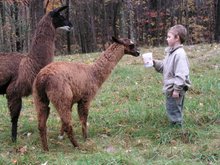
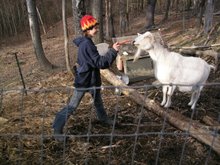

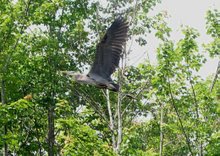

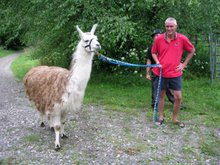
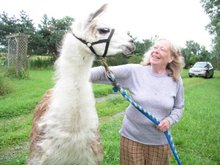
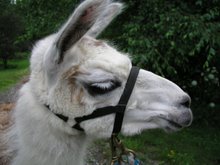








No comments:
Post a Comment